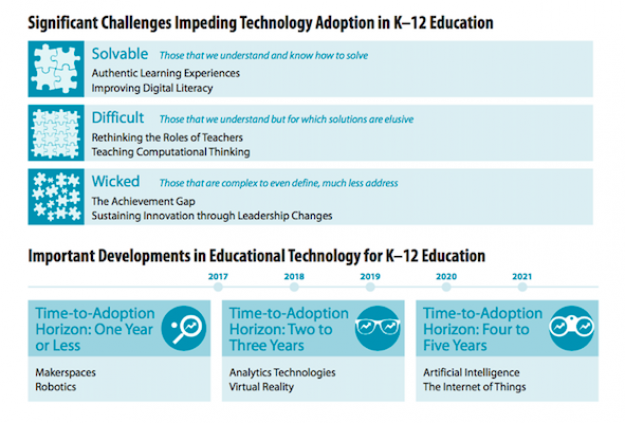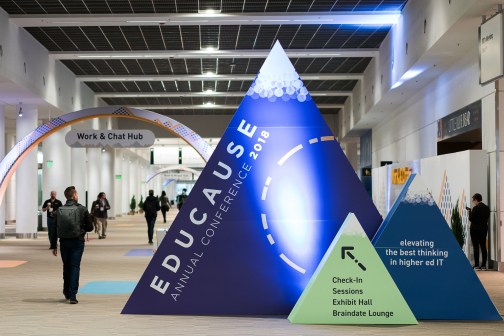On the horizon: Tech trends and challenges for the next five years

Makerspaces and robotics are expected to establish a prominent space in educational technology in the next year, with virtual reality, artificial intelligence and the Internet of Things not too far behind, according to about 60 education experts whose ideas are showcased in a new report.
But for those developments to be beneficial, schools must address a number of challenges impeding technology adoption in K-12 education — from improving digital literacy to teaching computational thinking and closing the achievement gap.
That’s according to the 10th annual Horizon Report from the New Media Consortium and the Consortium for School Networking (CoSN), which examines emerging technologies across K-12.
As students and teachers settle back into their normal school-year routines, edtech experts and associations like CoSN have been eager to forecast the future of classroom tech trends. This week alone, Blackboard published a white paper on the future of higher education and ISTE announced five tech trends to watch this year.
The NMC/CoSN Horizon Report draws from the ideas, experiences and discussions of 61 education experts and explores six trends, six challenges and six developments in edtech that have shaped teaching and learning and will likely continue to shape it over the next five years.
“People love looking at what the technology trends are, but the interesting thing about the report is it doesn’t start with the technology,” Keith Krueger, CEO of CoSN, told EdScoop. “It starts with what we are trying to fix or address in K-12, the challenges.
“We think the best way to use the report is to use it to spark a conversation, and to do that with people who might not normally read the report — to have a PTA meeting, a school board discussion, if you’re planning your technology plan.”
To encourage that dialogue, the New Media Consortium and CoSN also released a digital toolkit that provides resources and interactive tools, like a PowerPoint presentation, for understanding and explaining the ideas presented in the report.
“The report is not a tablet from heaven telling you the answers,” Krueger said. “The most important things is that you use it to start a conversation. [Ask yourself], ‘Here’s what a group of experts think, but do any of these problems address what we’re trying to do in our school or school district?’”
Each trend, challenge and development is broken down into three categories:
Short-term trends, which are expected to be at the forefront of edtech for a year or two, include coding as a literacy and the rise of STEAM (science, technology, engineering, math and the arts) learning as near term.
Mid-term trends, taking shape over the next three to five years, include the growing focus on measuring learning and redesigning learning spaces.
Long-term trends, which could dominate edtech for the coming five years and beyond, according to the report, include the advancing cultures of innovation and deeper learning approaches.
The challenges impeding technology adoption in primary and secondary education are classified by what is solvable, what is difficult and what is “wicked.” For example, improving digital literacy is considered a solvable challenge because educators understand it and know a solution exists, while closing the achievement gap is considered a “wicked” challenge that is complex to define and even more difficult to address.
Within the next year, the NMC/CoSN Horizon Report predicts that makerspaces and robotics will be widely adopted. A couple years after that, analytics technologies and virtual reality will be commonplace, and within the next five years, artificial intelligence and the Internet of Things will have exploded in edtech.
“It’s interesting how much things change,” Krueger said, referring to all the different technologies that have appeared in the report over teh years. “This provides kind of a road map.
“There are so many new technologies each year. How does the chief technology officer think about not only what is here today but what may be coming in the three-, four- or five-year range? I like the horizons it provides you.”




